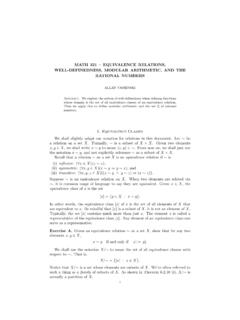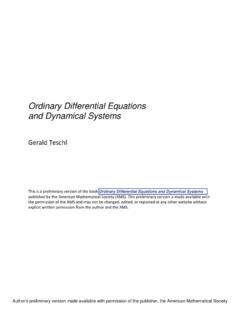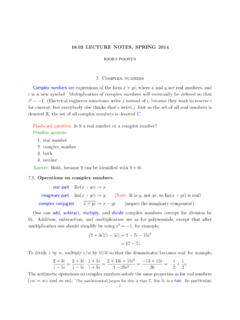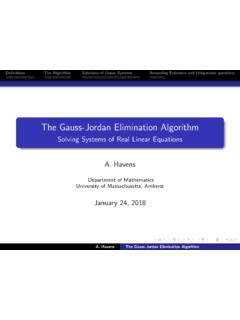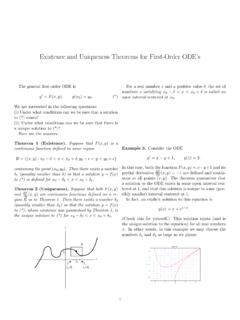Search results with tag "Existence and uniqueness"
Math 2331 { Linear Algebra - UH
www.math.uh.eduExistence and Uniqueness Theorem Theorem (Existence and Uniqueness) 1 A linear system is consistent if and only if the rightmost column of the augmented matrix is not a pivot column, i.e., if and only if an echelon form of the augmented matrix has no row of the form 0 …
Equivalence Classes
math.hawaii.edux2X, prove existence and uniqueness of z2Zfor which (x;z) 2g fseparately. To prove uniqueness, suppose (x;z 1);(x;z 2) 2g f, and show that z 1 = z 2.) EQUIVALENCE RELATIONS AND WELL-DEFINEDNESS 5 We can translate the de nitions of injectivity and surjectivity in terms of the set f. De nition. Let f X Y be a function.
NOTES ON THE EXISTENCE AND UNIQUENESS THEOREM …
people.math.wisc.eduexistence and uniqueness one first shows the equivalence of the problem (1.1) to a seemingly more difficult, but in fact more manageable problem of solving an integral equation. We have 2. Lemma1 3.1. Let x 7→φ(x) be a function with continuous derivative, defined in the …
Differential Equations I - University of Toronto ...
www.math.toronto.edu10.3 Existence and Uniqueness Theorem for Linear First Order ODE’s 155 10.4 Existence and Uniqueness Theorem for Linear Systems . . . . . . 156 11 Numerical Approximations 163
Differential Equations I
www.math.toronto.edu10.3 Existence and Uniqueness Theorem for Linear First Order ODE’s 155 10.4 Existence and Uniqueness Theorem for Linear Systems . . . . . . 156 11 Numerical Approximations 163
Ordinary Differential Equations and Dynamical Systems
www.mat.univie.ac.atThe basic existence and uniqueness result 36 §2.3. Some extensions 39 §2.4. Dependence on the initial condition 42 §2.5. Regular perturbation theory 48 §2.6. Extensibility of solutions 50 §2.7. Euler’s method and the Peano theorem 54 Chapter 3. …
System of First Order Differential Equations
www.unf.eduA(t)x(t)+b(t): The following theorem gives existence and uniqueness of solutions, Theorem 1.1. If the vector-valued functions A(t) and b(t) are con-tinuous over an open interval I contains t0; then the initial value prob-lem ‰ x0(t) = A(t)x(t)+b(t) x(t0) = x0 has an unique vector-values solution x(t) that is defined on entire in-
Chapter 3 Quadratic Programming
www.math.uh.eduLemma 3.2 Existence and uniqueness Assume that A 2 lRm£n has full row rank m • n and that the reduced Hessian ZTBZ is positive deflnite. Then, the KKT matrix K is nonsingular. Hence, the KKT system (3.3) has a unique solution (x⁄;‚⁄). Proof: The proof is left as an exercise. †
Math 361S Lecture Notes Numerical solution of ODEs
services.math.duke.eduThe following is a fundamental theorem about existence and uniqueness for ODE’s. Theorem 2.1. If f: [a;b] Rd!Rd is continuously di erentiable, then in a neigh-borhood [a;a+ ") around a, the solution to (2.1a){(2.1b) exists and is unique. Note that the solution may not exist for all t2[a;b] because the solution may diverge.
Variable coefficients second order linear ODE (Sect. 2.1 ...
users.math.msu.eduExistence and uniqueness of solutions. Remarks: I Every solution of the first order linear equation y0 + a(t) y = 0 is given by y(t) = c e−A(t), with A(t) = Z a(t) dt. I All solutions above are proportional to each other: y 1 (t) = c 1 e −A(t), y 2 (t) = c 2 e −A(t) ⇒ y 1 (t) = c 1 c 2 y 2 (t) Remark: The above statement is not true for solutions of second order, linear, homogeneous ...
18.03 LECTURE NOTES, SPRING 2014 - MIT Mathematics
math.mit.eduexistence and uniqueness theorem shows that there is a unique such function f(z) satisfying f0(z) = f(z); f(0) = 1: This function is called the complex exponential function ez. The number eis de ned as the value of ez at z= 1. But it is the function ez, not the number e, that is truly important. De ning ewithout de ning ez rst is a little ...
The Gauss-Jordan Elimination Algorithm
people.math.umass.eduDe nitions The Algorithm Solutions of Linear Systems Answering Existence and Uniqueness questions Echelon Forms Row Echelon Form De nition A matrix A is said to be in row echelon form if the following conditions hold 1 all of the rows containing nonzero entries sit above any rows whose entries are all zero,
Numerical Analysis
people.cs.uchicago.edu16.2 Existence and uniqueness of solutions 258 16.3 Basic discretization methods 262 16.4 Convergence of discretization methods 266 16.5 More reading 269 16.6 Exercises 269 16.7 Solutions 271 Chapter 17. Higher-order ODE Discretization Methods 275 17.1 Higher-order discretization 276 17.2 Convergence conditions 281 17.3 Backward ...
Analytic Solutions of Partial Di erential Equations
www1.maths.leeds.ac.ukExistence and uniqueness of solutions SolvingPDEsanalytically isgenerallybasedon ndingachange ofvariableto transform the equation into something soluble or on nding an integral form of the solution. First order PDEs a @u @x +b @u @y = c: Linear equations: change coordinate using (x;y), de ned by the characteristic equation dy dx = b a;
Existence and Uniqueness Theorems for First-Order ODE’s
faculty.math.illinois.eduTheorem 2 (Uniqueness). Suppose that both F(x;y) and @F @y (x;y) are continuous functions de ned on a re-gion R as in Theorem 1. Then there exists a number 2 (possibly smaller than 1) so that the solution y = f(x) to (*), whose existence was guaranteed by Theorem 1, is the unique solution to (*) for x0 2 < x < x0 + 2. x − 0 δ 2 x + 0 δ 2 0 ...

